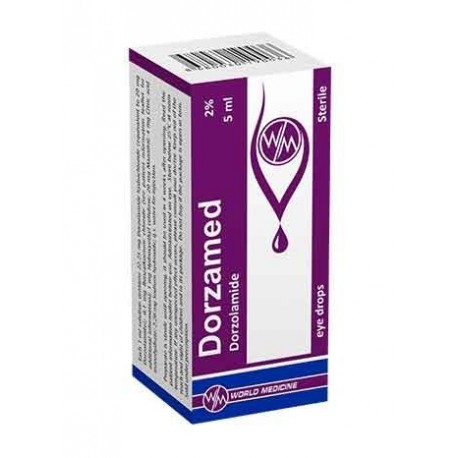 View larger
View larger Dorzamed (Dorzolamide Timolol, Generic Cosopt) Eye Drops 2.5% 5 ML
DRZM4496
New product
BUY MORE PAY LESS
| Quantity | Discount | |
|---|---|---|
| 2 | 5% | |
| 3 | 10% | |
| 4 | 15% | |
| 5 | 20% |
Volume discounts
| Quantity | Discount | You Save |
|---|---|---|
| 2 | 5% | Up to $3.70 |
| 3 | 10% | Up to $11.10 |
| 4 | 15% | Up to $22.20 |
| 5 | 20% | Up to $37.00 |
More info
DORZAMED 2% eye drops, solution
It is applied by dropping into the eyes.
Active ingredient
Each ml contains 22.25 mg dorzolamide hydrochloride equivalent to 20 mg dorzolamide.
Excipients
Benzalkonium chloride, hydroxyethyl cellulose, mannitol (E421), citric
2. What is DORZAMED and what is it used for?
Dorzolamide active substance contained in DORZAMED is included in a group of drugs called carbonic anhydrase inhibitors.
DORZAMED is an eye drop presented in a 5 mL self-dropping screw-cap bottle. It is practically a clear, colorless, slightly viscous, practically particulate-free solution.
3. How to use DORZAMED?
• Always take your medication as your doctor has told you. If you are not sure, consult your doctor or pharmacist.
• Your doctor will tell you the best dose and duration of treatment for you.
• When this medicine is used alone, its dose is given one drop in the morning, noon and evening to the eyes affected by the disease.
• If your doctor has told you to use this drug together with an eye drop called beta blocker to lower your eye pressure, the dose of DORZAMED is to give one drop to the affected eye (s) in the morning and evening.
• When you use this medicine with other eye drops, you should drip them at least 10 minutes apart.
• You should avoid the tip of the dropper touching your eye or its surroundings. If it is not applied carefully, it may be contaminated with common bacteria that cause eye infections, resulting in serious damage to the eyes and consequently loss of vision.
• To prevent possible contamination, always wash your hands before using the medicine and do not touch the dropper tip with any surface. If you think your medicine is contaminated or you have an infection in your eyes, consult your doctor about whether you can use the rest of the medicine.
Application route and method
DORZAMED is applied by dropping into the eye.
1. Take the DORZAMED bottle and a mirror.
2. Wash your hands.
3. Open the cover.
4. Hold the bottle with your thumb and fingers, with the tip pointing down.
5. Push your head back. Pull your eyelid downwards with the help of a clean finger until an area forms between your eye and eyelid. The drop will be dropped onto this area (picture 1).
6. Bring the tip of the bottle close to your eyes. Use a mirror if it helps.
7. Do not touch the tip of the bottle to your eye or eyelid, surrounding areas or other areas. May contaminate the drip.
8. Lightly press the bottom of the bottle turned downwards with your index finger, and a drop of DORZAMED will drip.
9. Do not squeeze the sides of the bottle. The design of the bottle requires a light press from the bottom (picture 2).
10. If you are going to apply the treatment to both eyes, apply the same steps for your other eye.
11. Tightly close the cap of the bottle immediately after use.
12. Use only one bottle at a time.
4. What are the possible side effects?
Like all medicines, DORZAMED may have side effects in people who are sensitive to the substances contained in its content.
[Very common (1/10); common (1/100 to <1/10); uncommon (1 / 1,000 to <1/100); infrequently 1 / 10,000 to <1/1000); very rare (<1 / 10,000)]
Stop using DORZAMED and IMMEDIATELY inform your doctor if you have any allergic reactions such as urticaria, swelling of the face, lips, tongue and / or throat, and therefore difficulty in breathing or swallowing.
These are all very serious side effects. If you have one of these, it means you have a serious allergy to DORZAMED. You may need urgent medical attention or hospitalization.
The following side effects have been reported with dorzolamide hydrochloride in the section on clinical studies and post-marketing experience.
Very Common: Burning and stinging sensation in the eyes.
Common: a disease of the cornea of your eye that causes pain and blurred vision (superficial mottled keratitis), a disease that causes itching and discharge in the eye (conjunctivitis), eyelid irritation and inflammation, blurred vision, headache, nausea, bitter taste, fatigue.
Uncommon: inflammation of the colored part (iris) around the pupil
Rare: tingling and numbness in hands and feet, myopia that heals when treatment is discontinued, fluid under the retina (choroidal detachment following filtration operation), eye pain, crusting on the eyelid, low pressure in the eye, swelling in the cornea (with signs of visual impairment), redness eye irritation, kidney stones, dizziness, nosebleeds, throat irritation, dry mouth, local skin rash (contact dermatitis), severe skin reactions, urticaria, swelling of the face, lips, tongue and / or throat, resulting in difficulty breathing or swallowing allergic reactions such as wheezing.

